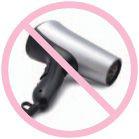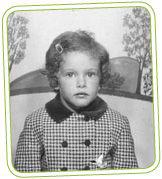B003YL4KS0 EBOK (28 page)
Authors: Lorraine Massey,Michele Bender

“When I tell clients that their gray hair is beautiful, I instantly see a shift in their outlook,” Larry says. And the best way to make your silver hair look better is to give it a foundation of hydration. “In reality, it’s not the color of the hair fiber that makes it beautiful, it’s the
quality
of the fiber. If hair is dehydrated, the tone and color change. So if you’ve been taking care of your hair by doing all the things we talk about in this book, automatically your silver hair will look better.”
“If you want to go natural,” Larry says, “focus on caring for your hair so that you can wean yourself off of color.” The other thing that affects how good your silver strands look is your hairstyle (or lack thereof). For example, if you have long, gray, straggly strands, your hair will have a dated appearance. But if your very hydrated silver hair has a stylish cut, it’ll look fabulous and, yes, youthful!
Another question clients often ask is how they can make the transition from colored hair to their natural hue. “Coloring can be an addiction, so you may have to wean off of it gradually,” Larry explains. “You can do this by coloring less in one way or another.” To do that:
•
Stop using permanent color. Instead, opt for demi- or semipermanent color, which doesn’t cover hair as fully so you will begin to see a gradual hint of your natural hair color. As a result, when roots come in there will be less of a line of demarcation than there is with permanent color, so your natural hue will be less shocking.
•
Another way to get used to going natural is to color most of your hair but leave some uncolored. A piece of hair in the front is a good place to try this, because you’re faced with your natural hue daily and begin to get used to it.
•
Rather than having hair colored completely, you can have it colored with highlights, using the Pintura technique (see
page 114
). Painting color on your natural hair will cover some of it but not all. For a dramatic effect, you can “add some pepper to the salt,” says Larry, by painting pieces of hair darker and leaving the rest white or silver.
•
Or you can go lighter in terms of the hue you color with. Going lighter better mimics what nature is doing as you age. Coloring with a lighter hue is an especially good idea if 75 percent or more of your hair is silver or white, because as hair grows in, there’s not a big contrast between your roots and your colored hair. And because your skin tone also changes as your hair gets gray, your complexion will be more compatible with a lighter hair shade.

TOO YOUNG TO DYEWhen clients ask colorist Michael Flores what to say to their tween or teen daughters who want highlights, he sees the daughter for a consultation. Then he explains that highlights require touch-ups every four to six weeks, that they can cause dryness, and that they are pricey. “I insist that the child pays for her hair coloring,” says Michael. “She needs to know this is something you don’t get free for the rest of your life and that it’s a responsibility. Then if she still wants it, I make her wait until she’s fifteen.”
CURLY COLOR CARE ISS-HUESMichael Flores, owner of the Michael Flores Salon in Dallas, Texas, is concerned that a lot of colorists treat curly hair the same way as straight hair, which you simply can’t do. Here are Michael’s top tips:
•
Beware of the brush.
If your colorist picks up a brush or comb when you sit in their chair, they’re going to treat your curls like straight hair. That’s a big mistake, and you should get up and walk out.•
Don’t go straight.
Never let a colorist blow out your hair to color it. If they do, they’ll be placing the color in areas that work for straight strands, not curly. Likewise, don’t let your colorist blow your hair straight after getting it colored. Some say this helps them see the color they’ve just applied to your hair. But this makes no sense if your hair was colored for you to wear curly. Plus, the damaging heat is a third strike against your hair after it’s been assaulted with color and shampoo.
•
Ask for the minimum.
The ammonia and peroxide in hair color and bleach can be very dehydrating to already dry, curly hair, so don’t be afraid to tell your colorist that you want the minimum amount of ammonia and peroxide used. (They do need to use some.)•
Get real.
Have realistic expectations about the kinds of color your curly strands can take. For example, you can’t be a double-processed blond and have healthy, pretty, curly hair. These two processes use high amounts of bleach and ammonia, so rather than being bouncy and shiny, your hair will probably look like yellow hay. (That is, if it doesn’t break off from all those drying chemicals!)•
Just touch-up.
If you have only a few gray strands, apply color only to them.•
Say no to the poo.
Shampooing hair after a color application removes some of the color that was just applied and ruffles the cuticle so the hair looks dull and dry.If you get your hair colored at the salon, protect all the good work and money you’re spending by bringing your own no-poo. Just take a bottle with no label on it and fill it with a sulfate-free cleanser or conditioner. Tell your colorist that you have a sensitive scalp and that your doctor says you must use this after coloring. After all, if you don’t protect your hair, who will?
DIY OR DYE
Ten Things to Do Before You DYEColoring your own hair isn’t as easy as it looks on TV commercials. You really need an artistic hand and a discerning eye. Plus, many of the at-home coloring kits have high concentrations of chemicals, which put your already dry curls at risk. Make a mistake and it takes longer for curly hair to recover from lost moisture. That said, an estimated 65 percent of women who color their hair do so at home, so I want to offer you some tips for doing it safely:
•
Avoid permanent color. Use only semipermanent or demipermanent color. With these, you’re less likely to make a mistake, or if you do, it will eventually wash out. Plus, semi- and demipermanent color cover gray hair well, give a gentle lift to your natural color, and enhance shine without damaging hair.•
Avoid “sun-activated” highlights. They’ll turn your hair orange!•
Don’t go more than two shades darker or one shade lighter than your existing color. Go for a neutral shade because you’re less likely to have a mishap. If you want a major color change, have it done by a professional colorist.•
If you highlight at home, have a friend help you. (And save the cocktails for later.) Look for a highlighting kit that contains a wand or brush that makes it easy to paint highlights on individual curls.•
When doing your roots, make sure not to overlap the new color onto the old color. “Apply color just to the roots or you’ll get a dark band in the overlap area,” says colorist Edward Fagley.•
Don’t run color all the way down to the ends. Some people say this refreshes them, but all it does is darken them.•
Leave on hair color for less time than what’s recommended on the box and never leave it on longer. Your hair will grab enough color, but you won’t have those damaging chemicals on your hair as long.•
If your curls look straighter after coloring, that’s not a good sign. It means the hair has been overprocessed and may have overlapped color.•
To see a truer color, go outdoors to look at it. Natural light will give you a better read of what your hair looks like than indoor fluorescent lighting.•
Know that semipermanent, demipermanent, and permanent color will not lift a previous color application. For instance, if your hair has been colored a light brown, you can’t make it lighter by adding an even lighter shade of brown. Only a professional colorist can make your hair lighter by using a professional color-removing process.
CURL CONFESSIONNathalie Wechsler
freelance illustrator, painter, and owner of a paper products companyWhen I was growing up, I was obsessed with the story of Rapunzel and her long hair. I loved giving my long-haired dolls different hairstyles, because my parents forced me to keep my own hair short. They thought curls were meant to be tamed. There is something about lots of curly hair that’s very sexual, and parents don’t like to see that in their kids. My parents wanted me to behave like a nice, quiet girl from a good family. So I kept my hair “quiet,” but I rebelled in other ways.
Then as soon as I was out on my own, I let my hair grow out and go wild. I now think that my fascination with Rapunzel’s hair had to do with becoming powerful and feeling in control. Rapunzel’s long hair gave her the power to escape from the tower. I grew my hair long when my parents were no longer able to control me—or my curls.
Today, people are fascinated by my curls; strangers stop me on the street, and many even ask if they can touch the curls. Finally, now that I’m in my forties, my parents accept my hair. But that was pretty recent. Just a few years ago, I’d be talking to my father, and he’d stop me and say, “Get your hair out of your face.”


